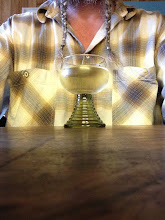'Hackney Wick stinks, it really does. On the last few weekends Julie and I have clambered off the No388 into it’s dystopian concoction of leftover hazard and contemporary apartment tower, spotted with bungaloid vagaries (could be a primary school, could be an old people’s home, could be an abandoned community centre) you can taste it in the back of your mouth. And each time as we orientated ourselves towards Adrian’s studio, his third around Dace Road within two years, we were at once perilously up and down the slip road of a motorway, way over a canal, hopping over puddles of wretched spray from an industrial waste facility and screamed past by Maseratis. And when we left Fish Island via the perilous pedestrian bridge, we were each time relieved, so to speak, to be back on dry land.
And in the distance lay the Olympic park, in all it’s
stunning mediocrity (I mean that as an emotional rather than strictly critical
response, because that’s what IT LOOKS
LIKE TO ME) and in front of us would stand Adrian, a skilled picture
framer, who had been forced to move there as if to some art ghetto, but was
plagued first by a nascent rock band next door, then freezing temperatures,
then condensation on his overhead pipes.
All of this, including the vicious physical topography,
provides an incredibly challenging site for the imposition of any kind of
architectural order. From the proximity of the vast and bogus Olympian
regeneration project; it’s conspicuous triumphal portal that is that orgy of
shopping, to the woeful peculiarity of something to be called a media village
(which one can only imagine as a city of media types, and just how awful that
might be) to the lives of the young artists of Dace Road, reminding me of my
own twenties with a studio in Metropolitan Wharf, Wapping, now barely
recognisable except in physical form, a transformation from habitat of the
newly liberated who cared not a jot for bathrooms even, to the newly minted who
need four or five at the same time, provided a bewildering arena of
opportunity, and bombarded young architectural minds with a huge range of intangibilities and possible
catastrophic errors, all of which go to make up the landscape our culture
deserves.
The Olympics itself represents one of those chimerical cash
cows that have seen sport transform to a gigantic pseudo spectacle, a ‘pop up’
Olympics, the ‘once in a lifetime experience’ that now occurs on an almost
weekly basis, with one pageant or another satiating our flagging attention
spans and filling our waistlines full of junk, where the rhetoric of Goebbels
meets the imperative of modern business. But I have read too many tedious
dissertations on the failure of Olympic regeneration (I think here especially,
tragically and emblematically, of Greece) that I expect a child of six to
understand what happens when totally contrived national fervour triumphs over
rational thinking.
To digest all this disarray will take along time. Student
projects are temporal, they occupy a particular time and space, conditioned by
a phrase such as ‘Well I did this when I was twenty two!’ or ‘This was my final
project!’ but always, since the intelligence is there (just later forgotten) it
will be worth each student looking back on these projects, and finding more to
them as they get older. Projects don’t really go away, unlike the sick (and I
mean sick) reality of a world of pop ups, they stay with you, even if they are about pop ups.


Projects don't go away- don't we bloody know it! look forward to reading the edit version that LSBU will publish, I didn't even realise that we had an end of year newspaper... Best
ReplyDelete